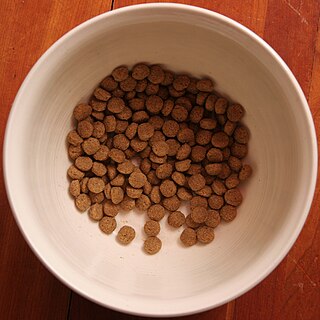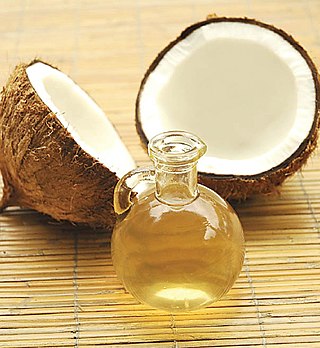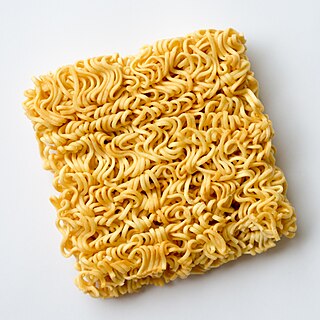Related Research Articles

Cooking, also known as cookery or professionally as the culinary arts, is the art, science and craft of using heat to make food more palatable, digestible, nutritious, or safe. Cooking techniques and ingredients vary widely, from grilling food over an open fire, to using electric stoves, to baking in various types of ovens, reflecting local conditions. Cooking is an aspect of all human societies and a cultural universal.

Food preservation includes processes that make food more resistant to microorganism growth and slow the oxidation of fats. This slows down the decomposition and rancidification process. Food preservation may also include processes that inhibit visual deterioration, such as the enzymatic browning reaction in apples after they are cut during food preparation. By preserving food, food waste can be reduced, which is an important way to decrease production costs and increase the efficiency of food systems, improve food security and nutrition and contribute towards environmental sustainability. For instance, it can reduce the environmental impact of food production.

In the field of food processing, pasteurization is a process of food preservation in which packaged and unpacked foods are treated with mild heat, usually to less than 100 °C (212 °F), to eliminate pathogens and extend shelf life. Pasteurization either destroys or deactivates microorganisms and enzymes that contribute to food spoilage or the risk of disease, including vegetative bacteria, but most bacterial spores survive the process.

Pasta is a type of food typically made from an unleavened dough of wheat flour mixed with water or eggs, and formed into sheets or other shapes, then cooked by boiling or baking. Pasta was traditionally only made with durum, although the definition has been expanded to include alternatives for a gluten-free diet, such as rice flour, or legumes such as beans or lentils. While Asian noodles are believed to have originated in China, pasta is believed to have independently originated in Italy and is a staple food of Italian cuisine, with evidence of Etruscans making pasta as early as 400 BCE in Italy.

Seafood is any form of sea life regarded as food by humans, prominently including fish and shellfish. Shellfish include various species of molluscs (e.g., bivalve molluscs such as clams, oysters, and mussels.

Dog food is specifically formulated and intended for consumption by dogs and other related canines. Dogs are considered to be omnivores with a carnivorous bias. They have the sharp, pointed teeth and shorter gastrointestinal tracts of carnivores, better suited for the consumption of meat than of vegetable substances, yet also have ten genes that are responsible for starch and glucose digestion, as well as the ability to produce amylase, an enzyme that functions to break down carbohydrates into simple sugars – something that obligate carnivores like cats lack. Dogs evolved the ability living alongside humans in agricultural societies, as they managed on scrap leftovers and excrement from humans.

Coconut oil is an edible oil derived from the kernels, meat, and milk of the coconut palm fruit. Coconut oil is a white solid fat below around 25 °C (77 °F), and a clear thin liquid oil in warmer climates. Unrefined varieties have a distinct coconut aroma. Coconut oil is used as a food oil, and in industrial applications for cosmetics and detergent production. The oil is rich in medium-chain fatty acids.

Browning is the process of food turning brown due to the chemical reactions that take place within. The process of browning is one of the chemical reactions that take place in food chemistry and represents an interesting research topic regarding health, nutrition, and food technology. Though there are many different ways food chemically changes over time, browning in particular falls into two main categories: enzymatic versus non-enzymatic browning processes.

Freeze drying, also known as lyophilization or cryodesiccation, is a low temperature dehydration process that involves freezing the product and lowering pressure, thereby removing the ice by sublimation. This is in contrast to dehydration by most conventional methods that evaporate water using heat.

Parboiled rice, also called converted rice, easy-cook rice, sella rice, and miniket is rice that has been partially boiled in the husk. The three basic steps of parboiling are soaking, steaming and drying. These steps make the rice easier to process by hand, while also boosting its nutritional profile, changing its texture, and making it more resistant to weevils. The treatment is practiced in many other parts of the world.

Modified atmosphere packaging (MAP) is the practice of modifying the composition of the internal atmosphere of a package in order to improve the shelf life. The need for this technology for food arises from the short shelf life of food products such as meat, fish, poultry, and dairy in the presence of oxygen. In food, oxygen is readily available for lipid oxidation reactions. Oxygen also helps maintain high respiration rates of fresh produce, which contribute to shortened shelf life. From a microbiological aspect, oxygen encourages the growth of aerobic spoilage microorganisms. Therefore, the reduction of oxygen and its replacement with other gases can reduce or delay oxidation reactions and microbiological spoilage. Oxygen scavengers may also be used to reduce browning due to lipid oxidation by halting the auto-oxidative chemical process. Besides, MAP changes the gaseous atmosphere by incorporating different compositions of gases.

Cranberry juice is the liquid juice of the cranberry – a fruit recognized for its bright red color, tart taste, and versatility for product manufacturing. Major cranberry products include cranberry juice, dried cranberry, cranberry sauce, frozen cranberry, cranberry powder, and dietary supplements containing cranberry extracts.

Soy protein is a protein that is isolated from soybean. It is made from soybean meal that has been dehulled and defatted. Dehulled and defatted soybeans are processed into three kinds of high protein commercial products: soy flour, concentrates, and isolates. Soy protein isolate has been used since 1959 in foods for its functional properties.

Food packaging is a packaging system specifically designed for food and represents one of the most important aspects among the processes involved in the food industry, as it provides protection from chemical, biological and physical alterations. The main goal of food packaging is to provide a practical means of protecting and delivering food goods at a reasonable cost while meeting the needs and expectations of both consumers and industries. Additionally, current trends like sustainability, environmental impact reduction, and shelf-life extension have gradually become among the most important aspects in designing a packaging system.

Meat science is the study of meat, including its production, preparation and preservation. Some meat scientists are studying methods of producing artificial meat such as cultures of muscle cells.

Instant noodles, or instant ramen, is a type of food consisting of noodles sold in a precooked and dried block with flavoring powder and/or seasoning oil. The dried noodle block was originally created by flash-frying cooked noodles, and this is still the main method used in Asian countries; air-dried noodle blocks are favored in Western countries. Dried noodle blocks are designed to be cooked or soaked in boiling water before eating. Ramen, a Japanese adaptation of Chinese noodle soup, is sometimes used as a descriptor for instant noodle flavors by some Japanese manufacturers. It has become synonymous in the United States with all instant noodle products.

Extrusion in food processing consists of forcing soft mixed ingredients through an opening in a perforated plate or die designed to produce the required shape. The extruded food is then cut to a specific size by blades. The machine which forces the mix through the die is an extruder, and the mix is known as the extrudate. The extruder is typically a large, rotating screw tightly fitting within a stationary barrel, at the end of which is the die.
Food powder or powdery food is the most common format of dried solid food material that meets specific quality standards, such as moisture content, particle size, and particular morphology. Common powdery food products include milk powder, tea powder, cocoa powder, coffee powder, soybean flour, wheat flour, and chili powder. Powders are particulate discrete solid particles of size ranging from nanometres to millimetres that generally flow freely when shaken or tilted. The bulk powder properties are the combined effect of particle properties by the conversion of food products in solid state into powdery form for ease of use, processing and keeping quality. Various terms are used to indicate the particulate solids in bulk, such as powder, granules, flour and dust, though all these materials can be treated under powder category. These common terminologies are based on the size or the source of the materials.

Case-ready meat, retail-ready meat, or pre-packaged meat refers to fresh meat that is processed and packaged at a central facility and delivered to the store ready to be put directly into the meat case.
A meat diaper or meat absorbent pad refers to the absorbent pad found in pre-packaged meats. Its purpose is to absorb the juices released from the meat during storage and transportation, helping maintain the meat's appearance and reduce spoilage. The case-ready meat almost always contain one or two meat diapers which absorb and retain the "purge", or the juices, blood, and other fluids that seep from the meats which may be unsightly for the consumer, leaks, is messy, and is often contaminated with bacteria.
References
- ↑ Huff-Lonergan, E. (2009). "Fresh meat water-holding capacity". Improving the Sensory and Nutritional Quality of Fresh Meat: 147–160. doi:10.1533/9781845695439.1.147. ISBN 978-1-84569-343-5.
- ↑ Cheng, Qiaofen; Sun, Da-Wen (31 January 2008). "Factors Affecting the Water Holding Capacity of Red Meat Products: A Review of Recent Research Advances". Critical Reviews in Food Science and Nutrition. 48 (2): 137–159. doi:10.1080/10408390601177647. PMID 18274969.
- ↑ Sman, Ruud van der (9 March 2015). "Getting a grip on water holding capacity". New Food Magazine. No. 1. Retrieved 29 April 2024.
- ↑ Brewer, M.S. (2014). "CHEMICAL AND PHYSICAL CHARACTERISTICS OF MEAT | Water-Holding Capacity". Encyclopedia of Meat Sciences: 274–282. doi:10.1016/B978-0-12-384731-7.00247-6. ISBN 978-0-12-384734-8.
- ↑ Pettersen, MK; Nilsen-Nygaard, J; Hansen, AÅ; Carlehög, M; Liland, KH (10 June 2021). "Effect of Liquid Absorbent Pads and Packaging Parameters on Drip Loss and Quality of Chicken Breast Fillets". Foods (Basel, Switzerland). 10 (6): 1340. doi: 10.3390/foods10061340 . PMC 8229185 . PMID 34200694.

